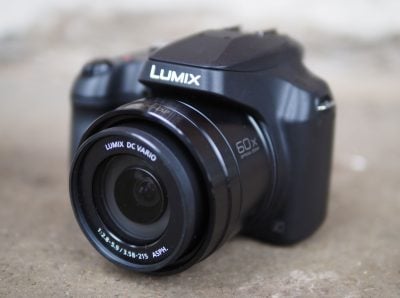Panasonic Lumix FZ80 / FZ82 review
-
-
Written by Ken McMahon
In depth
The Panasonic Lumix FZ82, or FZ80 as it’s known in North America, is a ‘bridge’ super-zoom camera with a 60x / 20-1200mm range, 18 Megapixel stills, and 4k video with 4k Photo features. Announced in January 2017, it’s the successor to the two-and-a-half-year-old Lumix FZ70 / FZ72.
The new Lumix FZ80 / FZ82 shares the same optical range as its predecessor, taking you from an unusually wide 20mm equivalent to a super-telephoto 1200mm, allowing you to grab expansive landscapes or tight interiors at one moment and close-ups of distant wildlife or the Moon at the other. Even after the crop applied by the 4k video / photo modes, the camera still delivers 28-1680mm coverage, and there’s also the ability to focus as close as 1cm. New to the FZ80 / FZ82 are the 18 Megapixel sensor giving it two over the FZ70 / FZ72, but more importantly allowing the camera to film 4k video at 24-30fps and support Panasonic’s clever 4k Photo modes which effectively capture 8 Megapixel stills at 30fps or let you refocus after the event. The sensor also supports an electronic shutter, extending the fastest shutter speed from 1/2000 to 1/16000, and continuous autofocus has improved with Panasonic’s DFD technology. Burst shooting is also up from 9 to 10fps, or 6fps with continuous autofocus.
The screen remains fixed, but now sports a higher resolution 1040k dot panel that’s touch-sensitive, and while the built-in viewfinder remains small in size, it too has received in boost in detail to 1170k dot. The FZ80 / FZ82 additionally offers 1080p video at up to 120fps for slow-motion and can now be charged over USB, both useful upgrades over its predecessor, but it’s the 4k capabilities that are the headliners. Read on to find out if it’s the super-zoom bridge camera for you in my in-depth review!
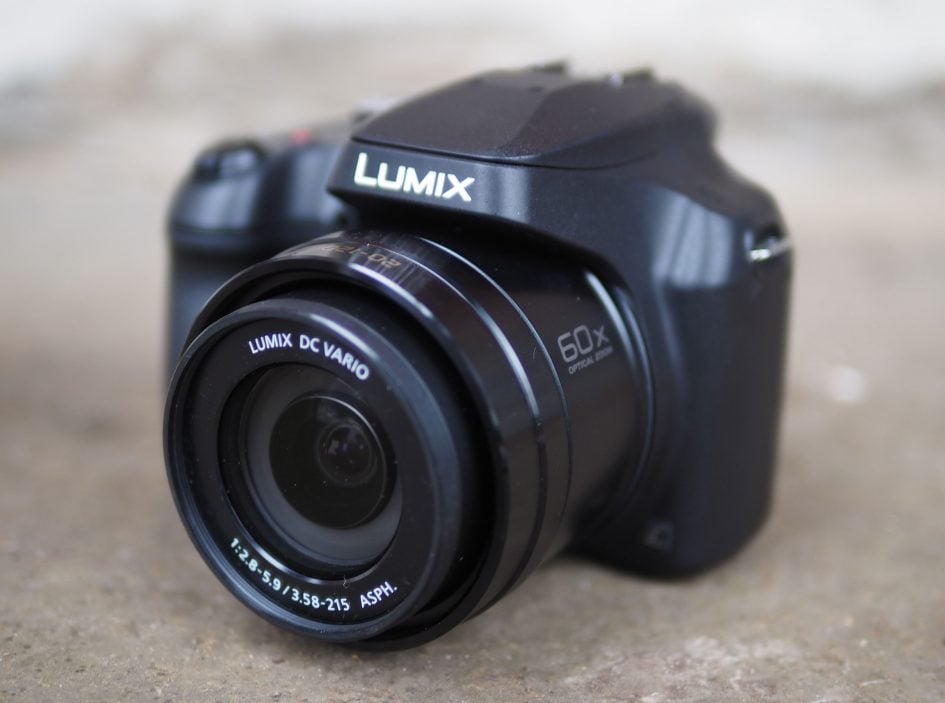
Panasonic Lumix FZ80 / FZ82 design and controls
The Lumix FZ80 / FZ82 is strikingly similar to the FZ70 / FZ72 it replaces. It’s a few millimetres shorter but the overall shape hasn’t changed and at 616g with the battery and a card it’s a mere 10g heavier. The Canon PowerShot SX60 HS is a little smaller all round but at 650g is also a bit heavier. The Nikon COOLPIX B700 is significantly smaller and 36g lighter so is the most compact of the three rivals. But none of these is going to fit in your coat, unless you have very capacious pockets. The price you pay for that long long zoom is a camera that’s getting on for DSLR weight and proportions. There are smaller compact super-zooms but at this price point you’ll have to compromise on the zoom range, or pay more, or both.
Personally I found the FZ80 / FZ82 to be a very comfortable model to carry around for a good part of the day and to shoot with. Its grip is a good size as is the rear thumb rest which extends all the way down the right edge of the rear panel.
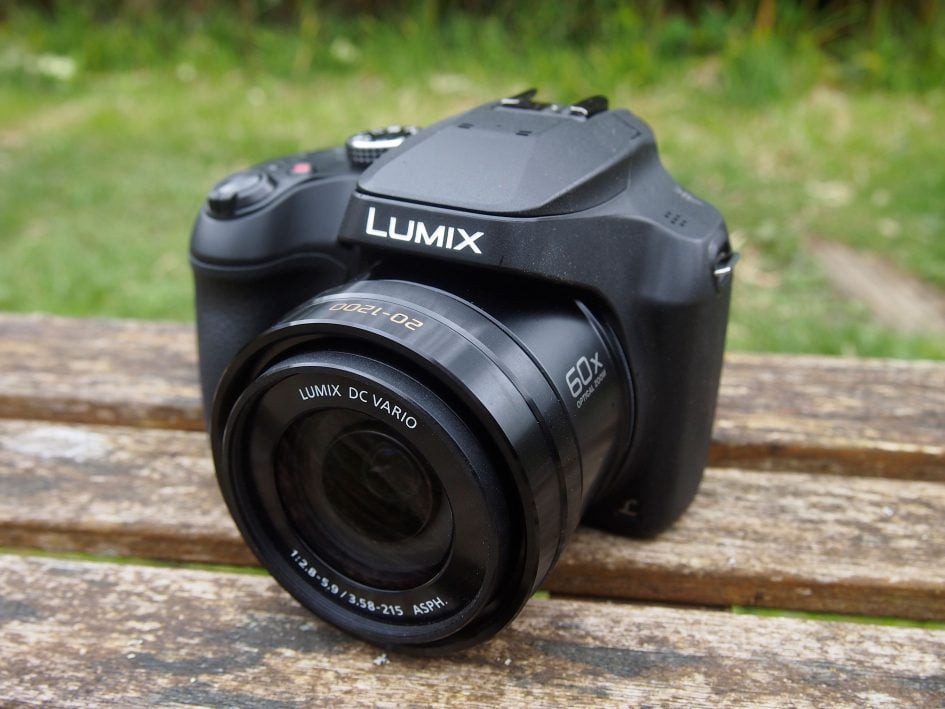
The control layout on the rear is little changed from the earlier model. There’s a button to the right of the viewfinder for toggling between the monitor and the electronic viewfinder and a dedicated AE/AF lock button next to it. Below that is a focus mode selector button and below that a playback button.
The four-way controller has ISO, white balance, self-timer and drive modes, and AF modes at its cardinal points with the menu button in the middle. Below it are the Q Menu / Delete and display overlay buttons.
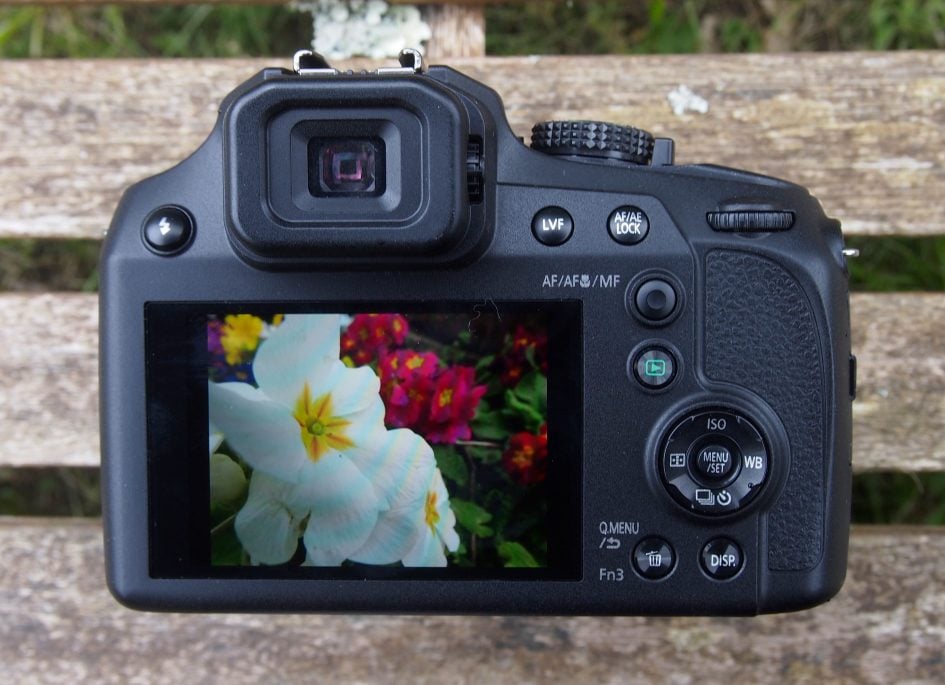
The one change here is the addition of drive modes, which previously had a dedicated button on the top panel, to the four way controller. The Q Menu button also doubles up as programmable function button f3. The two buttons on the top panel are assigned to the Lumix FZ80 / FZ82’s new 4K and post focus modes but can, if you want, be assigned to other functions so are also labelled Fn1 and Fn2. The top panel is otherwise largely unchanged but for a cosmetic redesign of the flash hump which loses the earlier model’s grilles covering the stereo mics.
Beneath a flap on the right side of the body you’ll find a mini HDMI port for connecting to an HDTV and a combined USB / AV port for downloading photos and video and for charging the battery. On earlier Panasonic Bridge super-zooms you had to remove the battery to charge it in the supplied AC charger. Charging the battery in the camera over USB opens up a whole new world of charging options including laptops, car chargers, battery boosters, in fact anywhere you can find an external USB power source and means you don’t have to take the mains charger with you on trips.
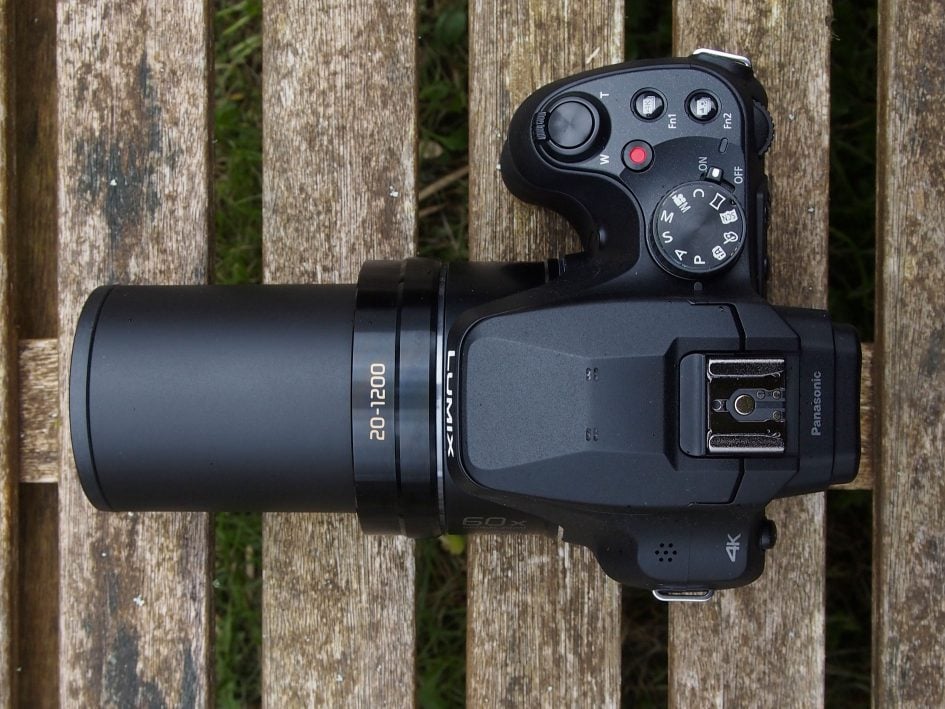
The combined battery and card compartment is located in the grip and accessed by a door in the bottom of the camera. The FZ80 / FZ82 no longer provides 200MB of built-in memory like its predecessor, but I don’t imagine too many people will mourn the loss.
The FZ70 / FZ72 takes the same DMW-BMB9E battery as used in the FZ70 / FZ72 and the FZ60 / FZ62 before it, so if you’re thinking of upgrading from one of those earlier models you can use any spares you have. The BMB9E is rated at 895mAh and provides enough energy to power the FZ80 / FZ82 for 330 shots if you exclusively use the monitor or 240 if you use the EVF. Whichever you use (most likely both and therefore somewhere in between) it’s a bit of a drop from the FZ70 / FZ72’s generous 400 shot allocation. It still compares pretty favourably with the 340 shots quoted for the PowerShot SX60 HS (though you can extend that to 450 shots in Eco mode). The COOLPIX B700 is the winner here, though, with a quoted 420 shots from a single charge.
The Lumix FZ80 / FZ82’s flash is raised by pressing a button to the left of the viewfinder on the rear panel. It’s hinged quite far back on either side of the hot shoe and consequently raises well above the lens, reducing the potential for red-eye and shadows on closer subjects.
In the PASM exposure modes the flash can be fired automatically when the conditions require it, or forced on; there are also Auto/Red-eye and Slow Sync/Red-eye modes. The red-eye modes fire a pre-flash to narrow the subject’s pupils and there’s also software correction available from the Rec menu.
The maximum distance quoted for the flash at the wide angle lens setting and with the ISO sensitivity set to Auto is 14.1 metres. That’s a pretty impressive performance (and about half a metre longer than the FZ70 / FZ72), generally the built-in flash units on bridge cameras aren’t that powerful and are only intended for use with reasonably close subjects or for fill-in. The Nikon COOLPIX B700 and Canon PowerShot SX60 HS, with maximum flash distances of 6.9 metres and 5.5 metres respectively are more typical, but as the figures for these models are also quoted using the Auto ISO sensitivity setting its difficult to make meaningful comparisons. Assuming the figure is given for 1600 ISO, it’s fair to assume that the FZ70 / FZ72’s flash does in fact deliver around twice as much power as the other two models.
If you want a more powerful flash the FZ80 / FZ82 provides the option to fit an external unit to its hot shoe. There are three Panasonic models available, the FL220, FL360 and FL500 with Guide Numbers of 22, 36 and 50 (Metres, 100 ISO) respectively.
Panasonic Lumix FZ80 / FZ82 Monitor and EVF
The Lumix FZ80 / FZ82’s screen was overdue for an upgrade and Panasonic hasn’t disappointed. The earlier FZ70 / FZ72’s 460 dot LCD monitor was a hand-me-down from the older FZ60 / FZ62 which itself had inherited it from the FZ47 / FZ48. The new screen more than doubles the resolution to 1040k dots but more importantly it’s touch sensitive, allowing tap positioning of the AF area as well as other benefits.
As before it’s still fixed, which is a bit of a shame as an articulated screen is so much more versatile. Both the Canon PowerShot SX60 HS and Nikon COOLPIX B700 feature vari-angle screens that can be flipped out to face in any direction including front-facing for self-shooting and folded inwards to protect the screen when not in use.
That said, neither of those two models features a touch-sensitive screen and if I had to choose between the two features I think I’d choose touch-sensitivity over articulation every time. As well as touching the screen to position the AF area, you can pull focus while shooting video using the FZ80 / FZ82’s touch-screen and it’s essential if you want to make the most of 4k shooting modes like Post Focus, where you can tap the screen to set the focus point after you’ve taken the shot. As well as that, the touch screen makes it a breeze to change camera settings and make menu selections.
On the right side of the Lumix screen there’s a small panel of touch icons which when tapped slides out to reveal more touch controls. From here you can activate the touch-shutter feature, apply a filter effect, set the AE metering area or access any of the touch function buttons, for example to turn on Wifi or access the 4K photo mode.
Of course the LCD screen isn’t the only, or possibly even the best way to compose shots on the Lumix FZ80 / FZ82. The Electronic viewfinder is also upgraded with a new 0.2 inch, 1.17 million dot panel. This provides a more detailed and more stable view than the 0.2 inch 201k pixel EVF in the older FZ70 / FZ72.
The viewfinder is 4:3 proportioned so the full area is used and there are no black areas at the edges, but it’s still quite small compared with more sophisticated and expensive panels used in mirrorless models and higher end super-zooms like the FZ200 which has a 2.3 million dot OLED viewfinder.
A fairer comparison would be with the similarly-priced Nikon COOLPIX B700 and Canon PowerShot SX60 HS. Both of these models sport viewfinders with a slightly lower 921k dot resolution, the Nikon COOLPIX, like the FZ80 / FZ82, has a 0.2 inch panel and the PowerShot SX60 HS’s is 0.17inch, so on paper there’s not a lot to separate them.
The FZ80 / FZ82’s EVF provides a reasonably detailed and stable image when neither the camera nor the subject are moving but things get a little jittery when panning or following moving subjects. One solution to this is to switch the Live view mode from its default 30fps refresh rate to the 60fps option. This results in a lower resolution display at double the refresh rate which produces a much more stable image, particularly when either the subject, the camera, or both are moving. I didn’t really notice the drop in resolution, so the improvement in stability makes it well worth switching to the 60fps mode, for moving subjects, just be aware it will consume more power.
Note: on my review sample, the diopter adjustment wheel was very loose and moved so easily that I had to adjust it every time I used the viewfinder. This rendered the viewfinder almost unusable, but I’m assuming it was a fault with my review sample as it’s not something I’ve ever experienced on other Panasonic models.
Panasonic Lumix FZ80 / FZ82 Lens and Stabilisation
The Lumix FZ80 / FZ82 retains the 60x optical zoom introduced on the previous FZ70 / FZ72. With a 35mm equivalent range of 20-1200mm this is an extremely versatile lens that has you covered in pretty much any situation, from large group shots and tiny interiors to sports and wildlife photography with everything in between from portraits and weddings to macro photography (at its wide angle setting the FZ80 / FZ82 can focus as close as 1cm).
Panasonic Lumix FZ80 / FZ82 coverage, wide and tele
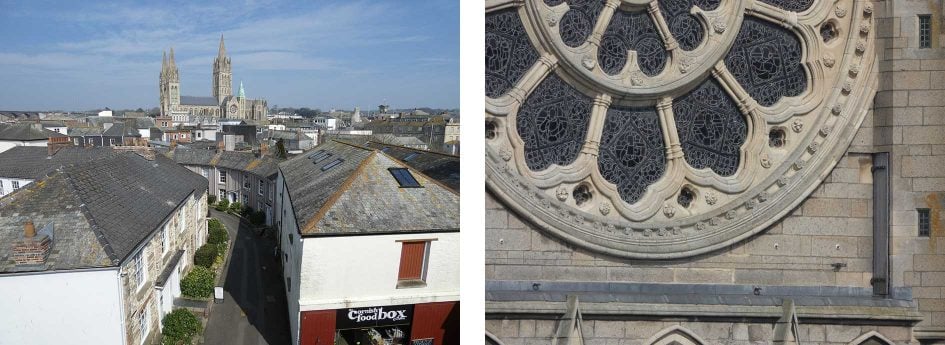
Above left: at 3.58mm (20mm equivalent), above right: at 215mm (1200mm equivalent)
A 1200 mm telephoto is pretty impressive, but far from unique and if it’s long reach that you’re looking for both the Nikon COOLPIX B700 and the Canon PowerShot SX60HS outgun the Lumix FZ80 / FZ82 with maximum zoom equivalents of 1440mm and 1356mm respectively. You have to be a little careful with these on-paper comparisons though; while the difference between the Lumix FZ80 / FZ82 and PowerShot SX60 HS may look significant, that 240mm won’t actually get you much closer to distant action.
At the other end of the range the FZ80 / FZ82’s 20mm super-wide-angle is wider than you’ll find on many bridge super-zooms in this class. That said, the Canon PowerShot SX60 HS comes close with a 21mm wide-angle equivalent and the Nikon COOLPIX B700 has a 24mm equivalent. 1mm isn’t going to make a great deal of difference, but if you like to shoot dramatic wide-angle landscapes, street scenes and interiors the Lumix FZ80 / FZ82 will give you an edge over the COOLPIX B700.
The Lumix FZ80 / FZ82 has a maximum aperture of f2.8, closing to f5.9 at the telephoto end of the zoom range. That’s unusually bright for a 60x optical zoom in this price bracket. The Canon PowerShot SX60 HS has a focal ratio of f3.4-6.5 and for the Nikon COOLPIX B700 its f3.3-6.5. So at the wide angle setting the Lumix FZ80 / FZ82 is around half a stop brighter which means, all other things being equal, you can shoot with a faster shutter speed or a lower sensitivity setting. Don’t forget that both the PowerShot SX60 HS and the the COOLPIX B700 have longer telephotos so at 1200mm they’re likely to be close to the f5.9 of the Lumix FZ80 / FZ82.
If a 1200mm telephoto isn’t long enough for you, the FZ80 / FZ82 is compatible with Panasonic’s 1.7x teleconverter lens accessory. With the DMW-LT55 converter attached the FZ80 / FZ82’s maximum telephoto range is extended to a whopping 2,040mm which will essentially fill the frame with the Moon.
The FZ80 / FZ82 is equipped with Power O.I.S image stabilisation which moves the lens elements to compensate for camera shake and permit hand-held shots at slower shutter speeds. To test the stabilisation I zoomed the lens to its maximum 1200mm focal length and took a series of shots in shutter priority mode at progressively slower shutter speeds first with the stabilisation turned off, then with it turned on. As you can see from the crops below, the Lumix FZ80 / FZ82 can shoot at shutter speeds as slow as 1/30 with the stabilisation enabled, a little over five stops slower than convention suggests is possible without it.
Panasonic Lumix FZ80 / FZ82 Power O.I.S Off/On
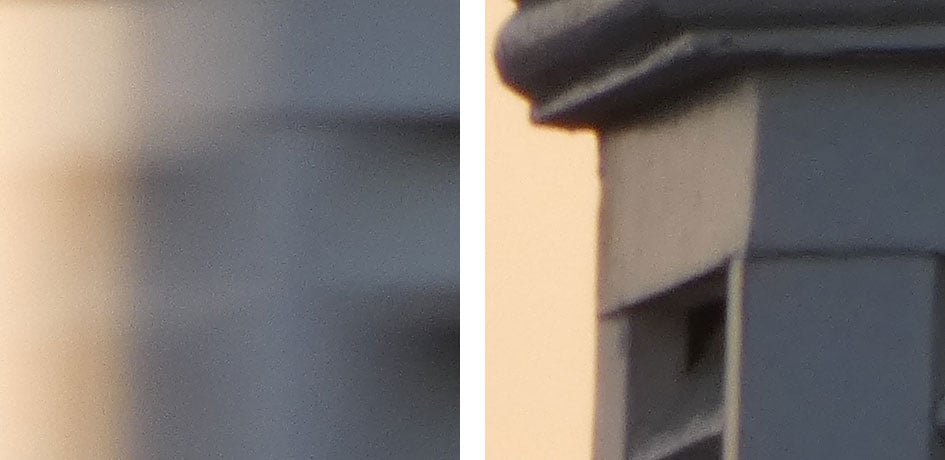
Above left: 100% crop, 3.58-215mm at 215mm 80 ISO 1/30th O.I.S off. Above right: 100% crop, 3.58-215mm at 215mm 80 ISO 1/30th O.I.S on.
Panasonic Lumix FZ80 / FZ82 Movies
Like its predecessor, the FZ80 / FZ82 has 1080p HD movie modes at 50 and 60 frames per second. New is 4k UHD video at 25 or 30fps along with Panasonic’s 4k Photo mode – a fun way of exploiting the fact 4k video captures an 8 Megapixel image up to 30 times a second. The clever part is Panasonic equips its 4k Photo cameras with software that lets you easily capture bursts of video before scrolling through the footage and extracting the perfect frame as a JPEG image, all in-camera. You could of course frame grab from video externally, but Panasonic has made it easy to perform the whole process in-camera; see later in the review for more details.
Returning to the FZ80 / FZ82’s movie modes, the 4k options record Ultra High Definition video (3840×2160 pixels) at 25 or 30fps and at a bit rate of 100Mbit/s in an MP4 wrapper. Unlike some higher end Lumix models, there’s no 24fps option to match the analogue film look so beloved of independent movie makers.
The FZ80 / FZ82 records 1080p at up to 28Mbit/s in MP4 mode. All the modes I’ve talked about so far are encoded in MP4 format, switch to AVCHD mode and you get the same 1080/50p mode as the MP4 format, encoded at 28Mbit/s plus two further 1080 / 50i interlaced modes – one encoded at 24Mbit/s from 25p sensor output and a 17Mbit/s mode from 50p sensor output. The 720p and VGA (640×480) modes of the earlier Lumix FZ70 / FZ72 have been dropped, and surely won’t be missed.
Other video features include snap movie, which records a short clip of between two and eight seconds in length. With snap movies you can set up a focus pull in advance tapping the screen to define the start and end focus positions, which is pretty neat. You can also add a monochrome to colour fade in our out effect, as well as a simple exposure fade. There are also Time Lapse and Stop Motion modes, accessed through the main menus rather than the movie options.
The FZ80 / FZ82 also has a High Speed video feature that shoots 1080p at 100fps for playback at 1/4 speed. If you want to slow down the action even more there’s also a 200fps option for 1/8 speed playback at VGA resolution. You can of course use editing software to convert 50/60p HD footage to 25/30p at 1/2 speed, but it’s so much more convenient to be able to shoot slow motion footage in-camera. The FZ80 / FZ82’s ability to shoot HD footage in slow motion puts it ahead of the competition. The Nikon COOLPIX B700 has a 720p mode that plays back at 1/2 speed and a 1/4 speed VGA (640×480) mode, and the Canon PowerShot SX60 HS with a 1/2 speed VGA mode and 1/4 speed playback at QVGA (320×240).
On the FZ80 / FZ82 you can shoot in PASM exposure modes, selected either from the video menu or by tapping the exposure mode icon in the top left of the screen when the mode dial is in the movie position. During recording you can change the exposure setting including, depending on the mode, aperture, shutter speed, ISO sensitivity and exposure compensation. While you can use the camera’s physical controls to alter the settings the touch screen provides a slide out panel allowing you to do so silently. You can also tap the screen to pull focus during recording.
Unlike the Lumix FZ330 / FZ300 and other higher-end Lumix bridge models, the FZ80 / FZ82 doesn’t offer Cinelike D and V profiles (for later grading) and also lacks the option that allows you to turn off the info display to allow the output of a ‘clean’ signal via the HDMI port. There’s no external microphone nor headphone socket; but you do get focus peaking and zebra patterns to help with focus and exposure. These aren’t features you’ll find on the COOLPIX B700 either, and although the PowerShot SX60 HS does have an external microphone socket, these kinds of pro video features aren’t what you’d expect, or even what most people would want, from a bridge camera in this price bracket.
Like the Lumix FZ80 / FZ82, the Nikon COOLPIX B700 also supports 4K video at 25 and 30fps as well as 1080p HD modes, and, as I’ve mentioned it has a couple of slow motion modes, but not at HD resolution. The COOLPIX B700 lacks a movie position on its mode dial, so it’s not as easy to frame up your shot, and if you plan to shoot a lot of video, this will make a big difference. The other, perhaps more important, difference is that the B700 doesn’t allow manual setting of the exposure for movies.
The Canon PowerShot SX60 HS lacks 4K capability – its best quality movie mode is 1080 / 60p. It does have a movie position on the mode dial though, plus it lets you set the exposure manually both before and during recording. That said, you’ll have to make these adjustments using the physical control buttons on the camera – on the FZ80 / FZ82 it can be done silently using the touch-screen.
Above: Download the original file (Registered members of Vimeo only). This first clip shows a hand-held panning shot followed by a zoom with the Lumix FZ80 / FZ82 in its best quality 4k mode at 25fps. The quality is great and the stabilisation at the maximum 1200mm focal length is impressive. The dual-speed zoom rocker is a little bit tricky, it took a few attempts to get this shot as I either went too far and zoomed at what seemed a frantic speed, or not far enough and ended up with an unintended zoom pause.
Above: Download the original file (Registered members of Vimeo only). For this tripod pan I disabled the stabilisation on the Lumix FZ80 / FZ82. The continuous AF is a little bit skittish here and on the way in the zoom motor sounds like a bag of spanners, but the image quality is hard to fault.
Above: Download the original file (Registered members of Vimeo only). For this low light interior panning shot the Lumix FZ80 / FZ82 copes very well with the changing lightlng and, considering the issues I had with noise on still images, it looks relatively clean.
Above: Download the original file (Registered members of Vimeo only). Finally, to test the touch focus on the Lumix FZ80 / FZ82 I zoomed in a little and tapped to focus on the coffee cup before starting recording then alternately tapping on the pictures on the far wall and the cup. After a slightly shaky start the FZ80 / FZ82 makes a great job of shifting the focus surely but unhurriedly from the cup to the background and back.
Panasonic Lumix FZ80 / FZ82 Shooting Experience
Panasonic has upgraded the AF on the Lumix FZ80 / FZ82, incorporating its DFD (Depth From Defocus) technology. DFD speeds up AF operation by using the lens characteristics to predict in which direction and how far the lens needs to be moved.
I must admit I don’t recall the older FZ70 / FZ72 being all that sluggish, at least in bright conditions, but the FZ80 / FZ82 is very quick and sure of itself. When shooting outdoors in good light it locks on and beeps almost instantaneously with a barely perceptible lag. Where other models often struggle is in poor light, particularly when zoomed in and though it can be marginally slower in these conditions, the FZ80 / FZ82 rarely takes more than a short fraction of a second to lock focus. Even when it has to travel from one end of the focus range to the other – a situation that often confuses contrast-detect AF systems – it rarely goes the wrong way, moving swiftly in the right direction and locking focus directly without hunting. About the only situation that slows the AF down significantly is shooting low contrast subjects in poor light with the lens zoomed in, when it can take a second or two to get its bearings.
The FZ80 / FZ82 has no fewer than six focus modes, Pinpoint, 1-Area, Custom Multi, 49-Area, Tracking and Face Detection. Face detection can detect up to 15 faces and lock focus on one of them. Multiple AF uses 49 areas to determine the best focus regions and there’s a single area AF option with a resizeable AF area that can be moved around the screen. Additionally there are three AF styles, the usual AFS and AFC single and continuous modes are joined by a third AFF, or Auto Focus Flexible mode. This is designed for shooting subjects like children and pets that move in an unpredictable manner.
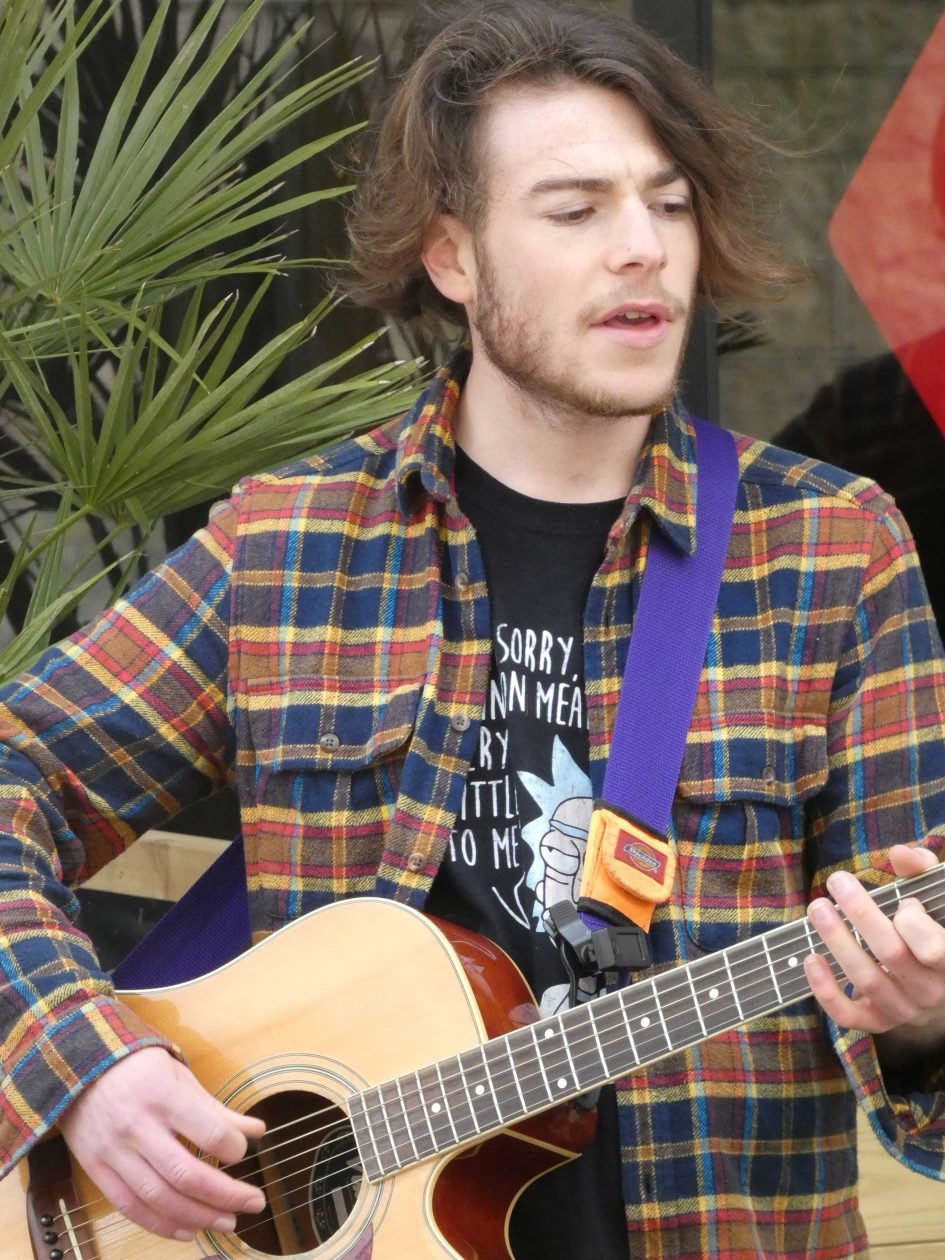
While it’s great to have updated AF area modes, it’s the touch screen that makes the biggest difference to focusing with the FZ80 / FZ82. You can simply tap the screen to position the AF area in single area mode. Custom Multi mode allows you to select a subset of the 49 areas arranged in a diamond configuration a single row or column, or a user defined pattern, then you simply tap the screen to position your AF grid.
If I was to make a criticism of the touch focus operation it would be that it’s easy to inadvertently reposition the grid with your nose when using the viewfinder, particularly if, like me, you use your left eye. That said, you can always turn touch AF off.
Manual focusing is selected with focus mode button on the rear panel which is also used to choose macro focus modes (there are two AF Macro and Macro zoom, the latter takes a crop from the centre of the frame). The focus is then adjusted using a slider on the screen. For manual focus the FZ80 / FZ82 offers the usual array of focusing assistance including a distance scale, MF assist, magnification and peaking. All of these make manual focusing easier than it would otherwise be, but it’s quite difficult to make fine adjustments which really limits manual focus to stationary, or at lease fairly immobile subjects.
The Lumix FZ80 / FZ82 also supports face recognition. Up to six faces can be stored along with name, D.O.B. and a custom AF icon. Focus and exposure are prioritised on recognised faces which can be registered manually, or you can set things up so that the camera automatically registers frequently shot faces. It’s a feature that’s popular on other Lumix models and undeniably great fun to see the names of people appear below their faces when they’re recognised.
Panasonic Lumix FZ80 / FZ82 Continuous Shooting
The Lumix FZ80 / FZ82 gets a slight improvement in continuous shooting speed over its predecessor from 9fps to 10fps. More importantly, it can shoot much longer bursts than the 3-frame limit of the Lumix FZ70 / FZ72. It also of course benefits from Panasonic’s 4K Photo modes which effectively provide 30fps continuous shooting at 8 megapixel resolution as well as other innovative features. So in this part of my review I’ll briefly cover the ‘conventional’ burst shooting features before going on to look at the 4K photo modes.
The Lumix FZ80 / FZ82’s continuous shooting features are accessed by pressing the drive mode button on the bottom of the four-way controller. There are three full resolution burst speeds available – High, Middle, and Low speed at 2fps, 6fps and 10fps respectively. All use the mechanical shutter and all but the fastest offer a continuous AF option at the same frame rate. If you set continuous AF the High speed burst rate drops to 6fps – which is the same as the Middle speed.
To test the Lumix FZ80 / FZ82’s continuous shooting I fitted it with a freshly formatted Lexar UHS-II card and set it to the best quality 18 Megapixel Fine JPEG resolution and the 10fps High speed burst mode. The FZ80 / FZ82 fired off a burst of 48 frames slightly faster than 10fps before slowing to around 3-4fps. In RAW mode I got a burst of 14 shots, again slightly quicker than the quoted 10fps before things stalled and slowed down considerably.
That’s a massive improvement on the continuous shooting capabilities of the older Lumix FZ70 / FZ72. While you won’t notice much difference between 9 and 10fps, the ability to shoot a burst of nearly five seconds makes capturing action sequences a reality, whereas with the 3-frame limitation on the Lumix FZ70 / FZ72 it was almost impossible. It also compares pretty favourably with the competition. Canon’s PowerShot SX60 HS manages 6.4fps at full 16 Megapixel resolution and, although it offers a raft of low resolution high speed burst modes, the best full resolution 20 Megapixel continuous shooting mode on the Nikon COOLPIX B700 is 5fps.
So the Lumix FZ80 / FZ82 beats the competition on its continuous shooting modes, but, as I mentioned earlier, it also benefits from Panasonic’s innovative 4K Photo modes including 4k Photo (effectively capturing 8 Megapixel stills at 30fps), Post Focus (which racks the focus during capture to let you later extract the one at the desired point of focus), and the latest Focus Stacking (which again racks the focus during capture but then lets you create a stacked image in-camera between a defined range of distances).
4K Photo mode exploits the fact 4K video actually contains 8 Megapixels worth of information on every frame, so why not use it for capturing reasonable quality stills at high frame rates? There’s three options: Burst (which records video while the shutter button is pressed), Burst S / S (which starts recording with one press and stops with another), and 4K Pre-burst (which keeps a one-second rolling buffer to avoid unwieldy clips to store and go through). I ended up using the Pre mode more often than not. When you press the shutter in Pre-burst mode, the camera records two seconds / 60 frames worth of action: you get the second before you pressed the button and the second after. So if you press the button as soon as the action has just happened, you should have a frame which includes some part of it from a moment earlier.
When you play the capture back, you’re shown a still photo rather than a video clip, with the option to cycle through the frames quickly by pressing the left or right arrow keys. This makes it very easy to jog back and forth before selecting the perfect moment, after which a press of the Menu / Set button saves the frame as a new JPEG with 8 Megapixel resolution. You can’t save RAW files in the 4K Photo mode, but you can choose the aspect ratio prior to capture along with having full control over the focus, exposure mode, aperture, shutter and ISO.
The 4K Photo mode is great for capturing the perfect moment when faced with fast action, but it’s also surprisingly useful for portraits, especially of kids, where an expression can change between frames.
During a short video clip the Post Focus mode attempts to shift the focus between all the subjects in the frame, near and far. If successful, this short video clip essentially contains frames where any part of the composition is in focus, and it only takes a few seconds to capture. The clever bit is in playback where the camera lets you tap anywhere on the screen and the camera automatically selects the frame from the video where it’s in focus, offering focus-peaking to further help you make the choice. Like the 4K Photo modes, it then lets you export it as an 8 Megapixel JPEG.
The third Post Focus mode – Focus Stacking – combines frames to produce a composite with greater apparent depth of field than you’d get from an individual frame. It’s particularly useful when the lighting conditions force you to shoot with a wide aperture or in macro photography where the depth of field is always very shallow.
Post focus is more than just a gimmick, like 4K photo it’s a feature that takes advantage of the 8 Megapixel resolution available in 4k video frames to improve your chances of getting a great still image that truly captures the moment. The three images below, all taken from one Post Focus capture, give an idea of just how much focus flexibility it provides. In the first I’ve selected the focus area closest to the camera, for the second it’s furthest away and the final one is a focus stacked image showing everything from the nearest to the furthest pencils in focus. Post Focus isn’t flawless though, note the stacking artifacts in the pencils closest to the lens in the final stacked image below.
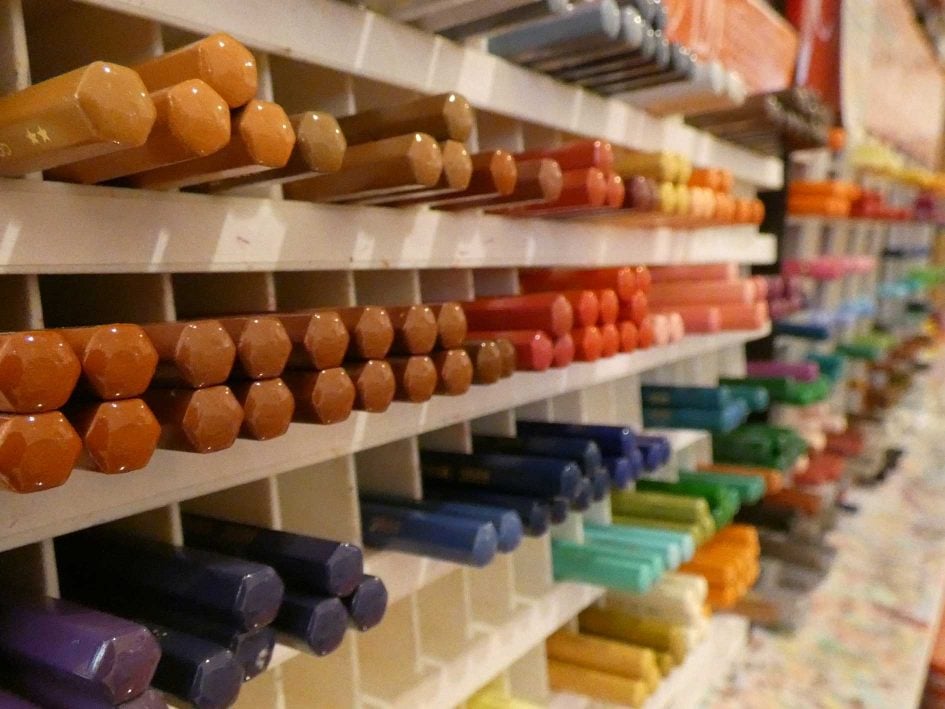
Panasonic Lumix FZ80 / FZ82 Post Focus near
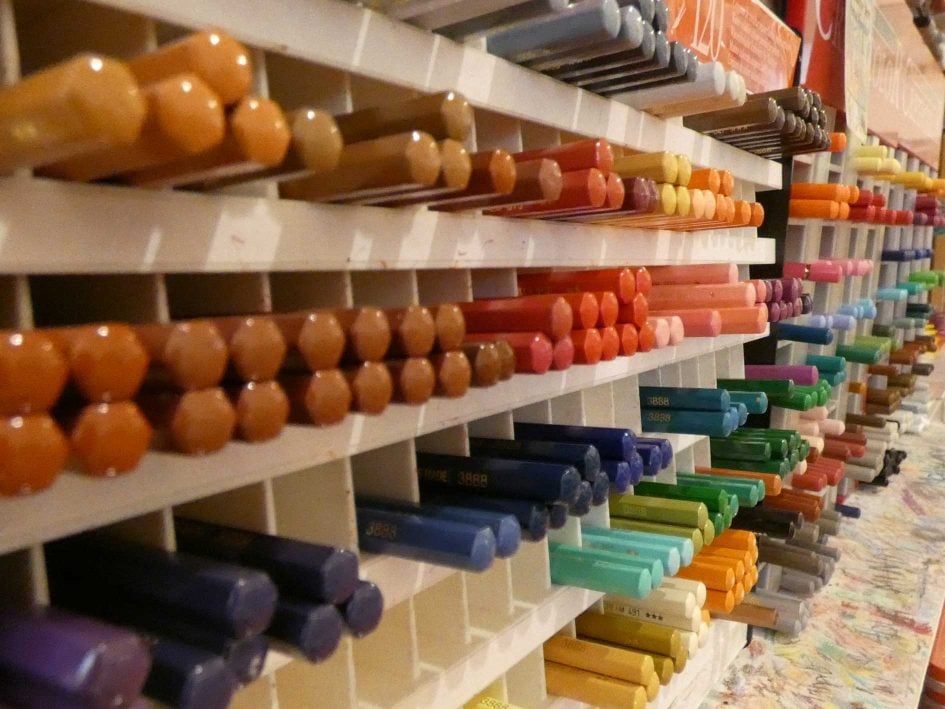
Panasonic Lumix FZ80 / FZ82 Post Focus far
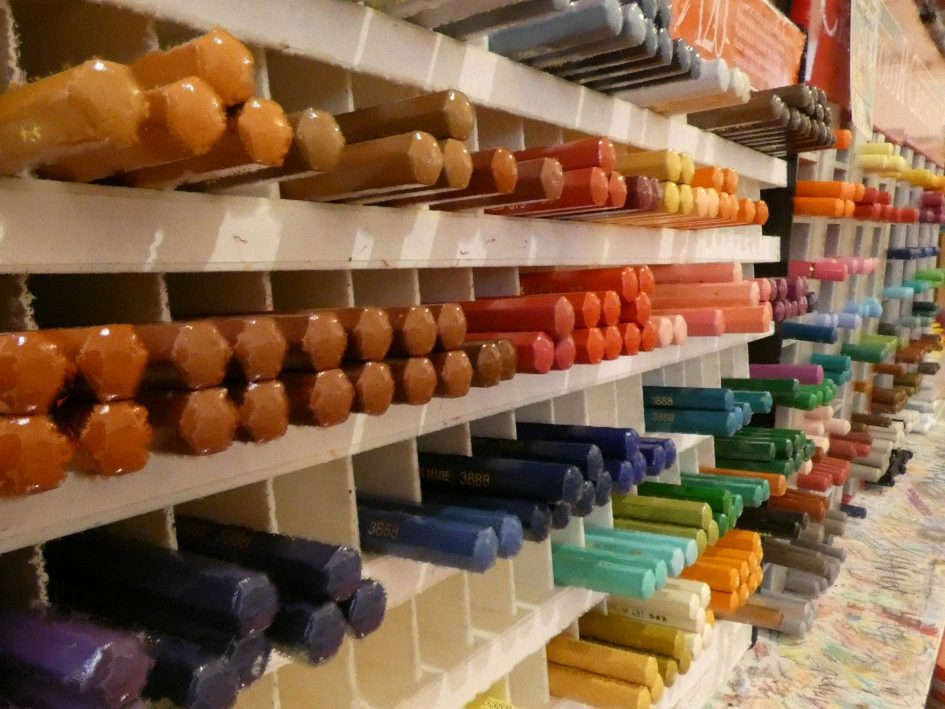
Panasonic Lumix FZ80 / FZ82 Post Focus stacking
Panasonic Lumix FZ80 / FZ82 Wifi
As you’d expect, the FZ80 / FZ82 has Wifi support that allows you to wirelessly transfer images from the camera and operate it remotely using a smartphone. It doesn’t have an NFC chip, that’s not a huge drawback though, as you can quickly establish a connection manually.
Wifi allows you to wirelessly browse the FZ80 / FZ82’s images on the larger and more detailed screen of a smartphone or tablet, copy them onto these devices, upload them to online storage or social media services (either directly or via a smartphone), or become remote-controlled using the free Lumix Image app for iOS or Android devices.
Once your phone or tablet is connected to the FZ80 / FZ82, you can remote control it, browse the images direct from the memory card, copy them onto the handset and if desired send them onto various storage or sharing services. You can also set the app to make a GPS log for subsequent syncing and tagging, create a snap movie, or photo collage.
The remote control feature shows a live image on your phone or tablet’s screen allowing you to take a photo or start or stop a video recording. You can drag the AF area to position it just as you would on the camera screen. If the camera’s mode dial is set to Aperture or Shutter Priority, you can remotely adjust the aperture or shutter speed respectively, and in Manual you can change both.
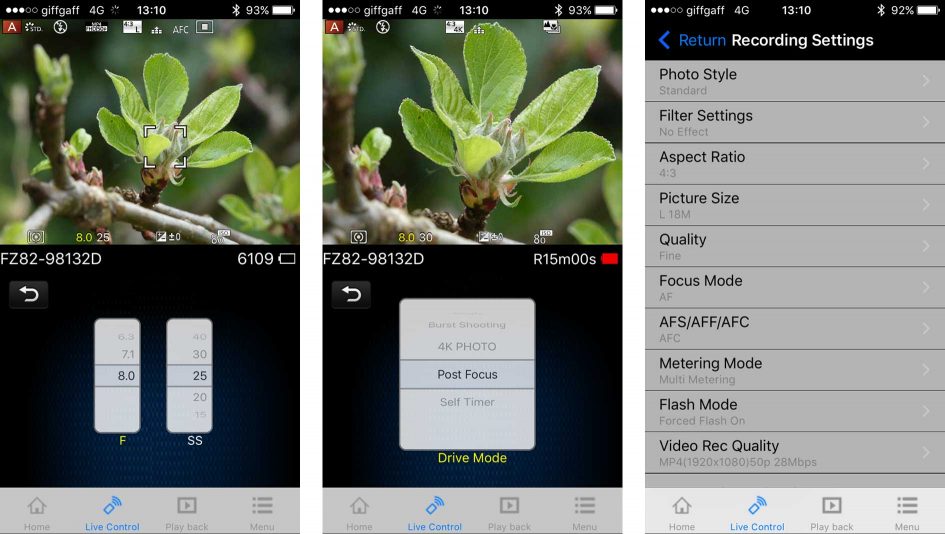
The Panasonic Image App provides access to the widest range of settings and controls of pretty much any Wi-Fi remote shooting app available. You can adjust the ISO, white balance, exposure compensation or focus area, and there’s also a Q.Menu button which presents a list of additional options you can remotely change including the focus and metering modes, aspect ratio, resolution, compression, macro mode, photo style or movie quality. You can also select burst shooting, 4K photo modes and self-timer options.
You can’t change the drive mode remotely, that has to be done using the dial on the camera, however once you’ve set a drive mode it is then possible to alter, say, the continuous shooting speed, or self-timer delay.
There are two options for transferring images; Batch transfer provides a menu from which you can select options to transfer the current day’s images, or you can include the last 3, 7 or 30 days, or if you’re feeling impetuous you can opt to transfer everything. Further options allow you to restrict transferred files to just photos or videos. If you want to browse the images on the card in the camera before deciding which to transfer, then Transfer selection is the option to go for.
To maintain a responsive experience which feels like the images are stored locally on your phone or tablet, the camera sends a lower resolution version. So you can pinch to zoom-in a little, but not as much as if you were viewing the original. When you see an image you like, just tap it and the Lumix Image app will let you save the original to your device or start uploading it to one of the social, sharing or storage services installed on your device. You can configure the app to provide shortcuts to two or three of your most used services which could include Dropbox and Instagram in addition to the more usual suspects. Or of course once the image is copied into your device, you could just exit the Panasonic app and handle it direct from whichever sharing or storage app you like via your phone’s gallery.
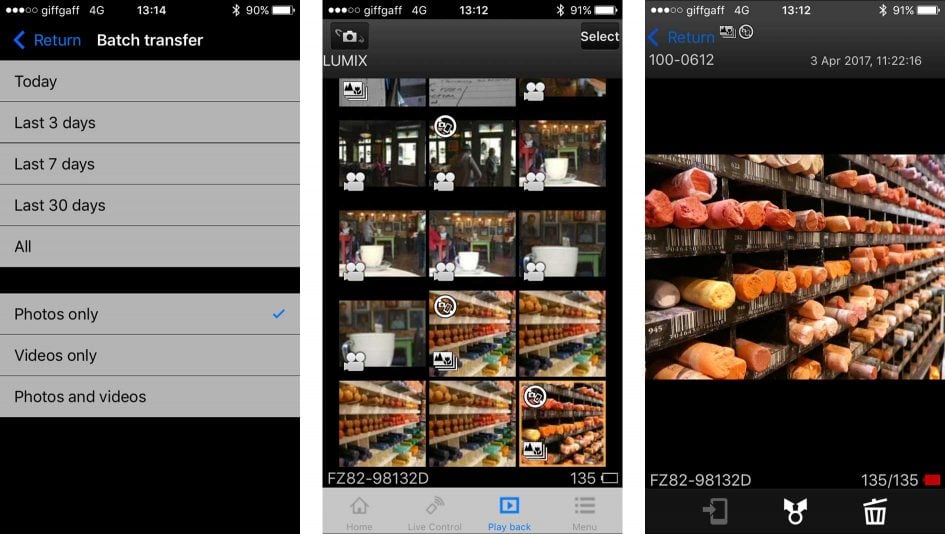
You can also choose whether to copy images in their original resolution, or in one of two smaller versions. It typically took about 5 seconds to copy an original JPEG from the camera to my iPhone 6 from a distance of about 1m; it’s not possible to copy RAW files though.
The Lumix FZ80 / FZ82 can also upload images directly to the internet by itself via a suitable Wifi connection. You can upload directly to Facebook, Twitter, Picasa, Youtube, Flickr, but there’s two gotchas. The first is the camera doesn’t have any kind of built-in browser to accept the terms and conditions of public hotspots, so you’ll mostly be using home or office-based Wifi. The second problem is before letting you upload anything directly from the camera you’ll first need to register for Panasonic’s free Lumix Club.
To be fair, the approach is not dissimilar to the way most other manufacturers implement direct uploads, but to me it makes more sense to just use Wifi to copy the image from the camera to a more capable device and upload from there instead.
Finally, the Lumix Image app allows the FZ80 / FZ82 to inherit the fun Jump Snap feature introduced with the GF7. This uses the accelerometer in your phone to trigger the shutter remotely as you jump in the air. It works surprisingly well too. Using the app you can remotely view the composition and refocus the camera if necessary, before then setting the sensitivity of the jump detection. After a little fine-tuning of the sensitivity you’ll be able to capture the perfect moment when you’re at the top of your leap. It’s a really fun way to exploit the technology in your pocket.
For me, Panasonic provides one of the best wi-fi experiences of any camera manufacturer both for image transfer and remote control and shooting. But Nikon is making big strides with its Snapbridge technology which automatically transfers images to your phone while you shoot via a low power Bluetooth connection. It also has NFC, making for quick and simple connections with suitably equipped Android phones. Having said that, the Nikon App’s remote shooting capabilities are, to put it kindly, in the Stone Age by comparison with what Panasonic provides.
Like the COOLPIX B700 the Canon PowerShot has NFC for tap connecting with an NFC Android phone. I’d say the Canon app’s image transfer features lag behind Panasonic’s a little, but if all you want is a simple way to wirelessly transfer images to your phone for onward sharing the SX60 HS get’s the job done. Canon’s remote shooting features are, like Nikon’s, pretty basic, so if you’re looking forward to make the most of remote shooting opportunities using your phone or a tablet, the Lumix FZ80 / FZ82 wins hands down.
The Lumix FZ80 / FZ82 is well catered for when it comes to time lapse sequences with the choice of a traditional interval timer (Time Lapse Shot mode) or one which lets you take photos manually as and when each frame is ready (Stop Motion Animation).
The FZ80 / FZ82 also includes the Panoramic Shooting mode introduced way back on the FZ200. The FZ80 / FZ82 takes a sequence of shots as you rotate the camera to capture a panoramic scene and then assembles them in-camera to a single image. You can hold the camera in portrait or landscape mode, you have to specify which in advance. Finished panoramas are a maximum of 7680 x 2560 pixels. Providing you keep on turning and keep the camera reasonably level the FZ80 / FZ82 will record a complete 360 view. If you’re a little uneven, or the subject makes it difficult to record overlapping images it will stop part way through and produce a panorama from what it has managed to capture – or you can press the shutter a second time to finish at a particular point. All in all it’s very simple to use and produces very good results.
Finally, I should also mention Creative Control mode. Panasonic introduced Creative Control filter effects on the FZ47 / FZ48 and extended the range on the FZ150 with the addition of eight new options. The FZ70 / FZ72 added a new one – Old Days, a variation on Retro, less warm and with a slight magenta cast, making fifteen in all. With the FZ80 / FZ82 the list has now expanded to 22 with several monochrome options, bleach bypass, Fantasy, and Sunshine in addition to old favourites including Expressive, Retro, Old Days, High Key, Low Key, Sepia, Dynamic Monochrome, Impressive Art, High Dynamic, Cross Process, Toy Effect, Miniature Effect, Soft Focus, Star Filter, and One Point Colour.
Check prices at Amazon, B&H, Adorama, or Wex. Alternatively get yourself a copy of my In Camera book or treat me to a coffee! Thanks!
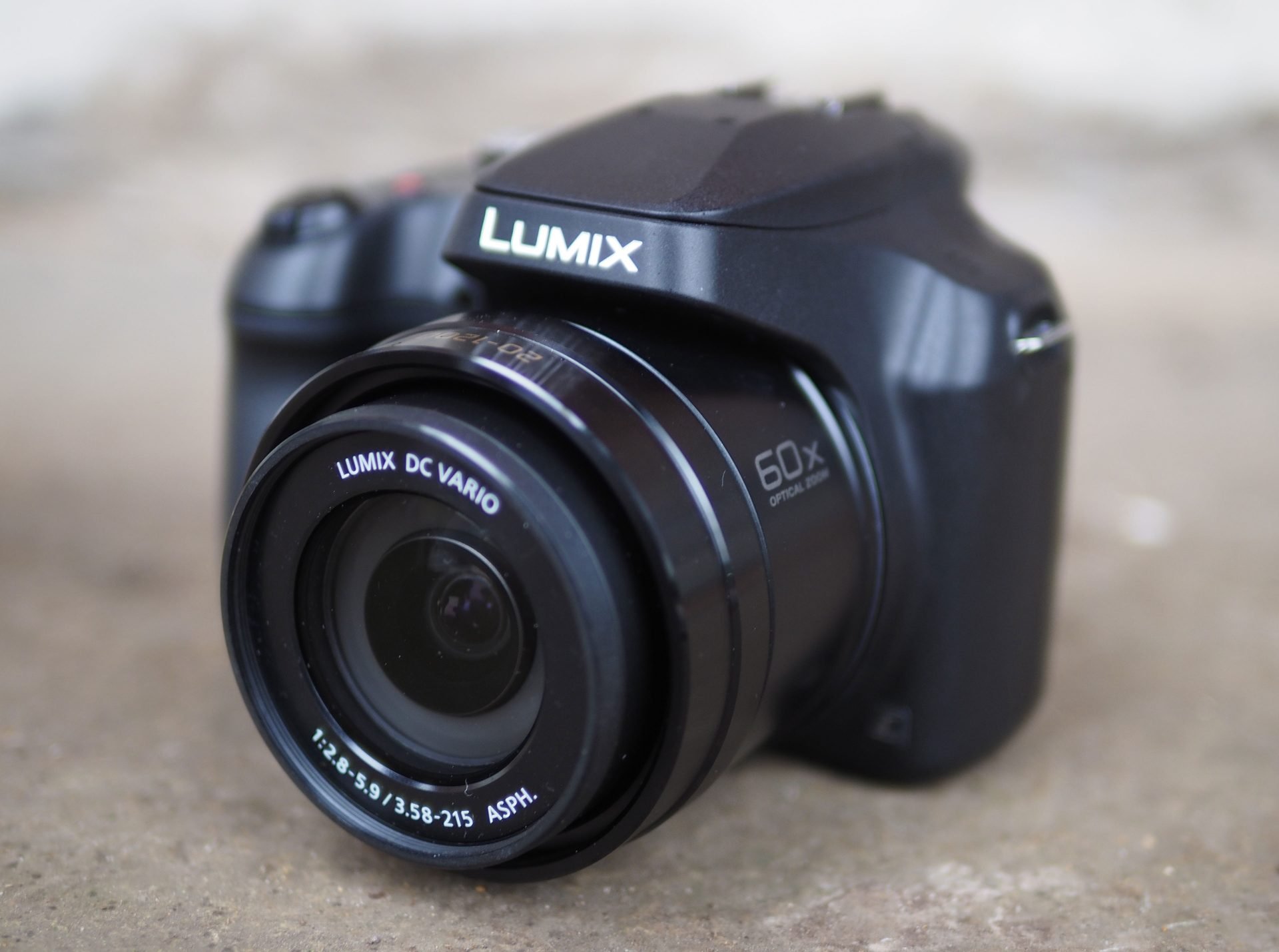
 The Panasonic Lumix FZ80 / FZ82 is a bridge super-zoom with a 60x optical range. It updates the Lumix FZ70 / FZ72, retaining the older model's 20-1200mm lens, but with a new 18 Megapixel sensor, an upgraded 3 inch 1040k dot fixed touch screen, and a more detailed 0.2in 1.7 Million dot EVF. Also new are 4K video and 4K Photo modes, excellent Wifi for wireless shooting and image transfer, faster continuous shooting, improved AF with Panasonic's Depth from Defocus technology and USB charging. It's got just about everything you could wish for in a bridge camera at this price bar an articulated screen, so comes highly recommended.
The Panasonic Lumix FZ80 / FZ82 is a bridge super-zoom with a 60x optical range. It updates the Lumix FZ70 / FZ72, retaining the older model's 20-1200mm lens, but with a new 18 Megapixel sensor, an upgraded 3 inch 1040k dot fixed touch screen, and a more detailed 0.2in 1.7 Million dot EVF. Also new are 4K video and 4K Photo modes, excellent Wifi for wireless shooting and image transfer, faster continuous shooting, improved AF with Panasonic's Depth from Defocus technology and USB charging. It's got just about everything you could wish for in a bridge camera at this price bar an articulated screen, so comes highly recommended.



